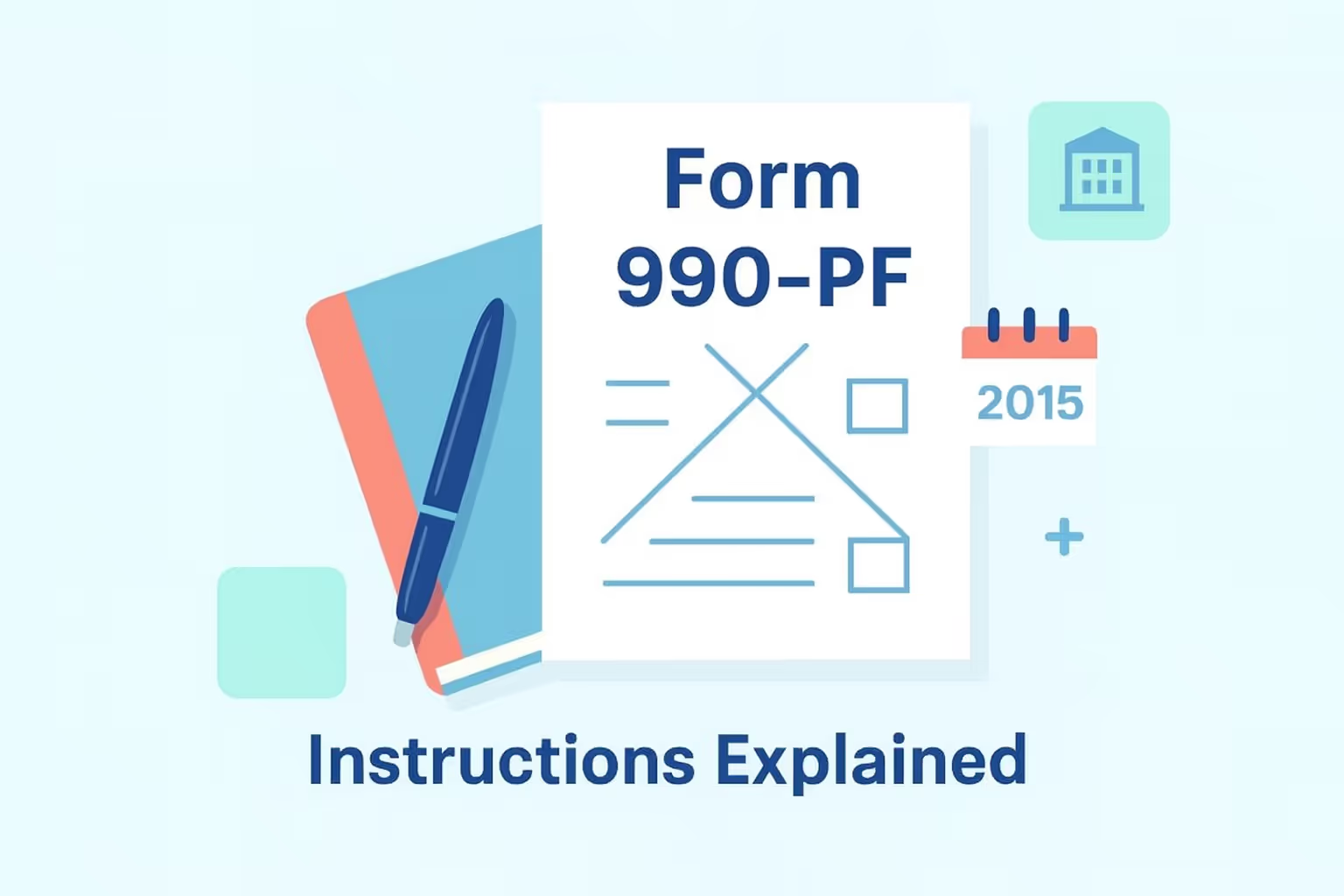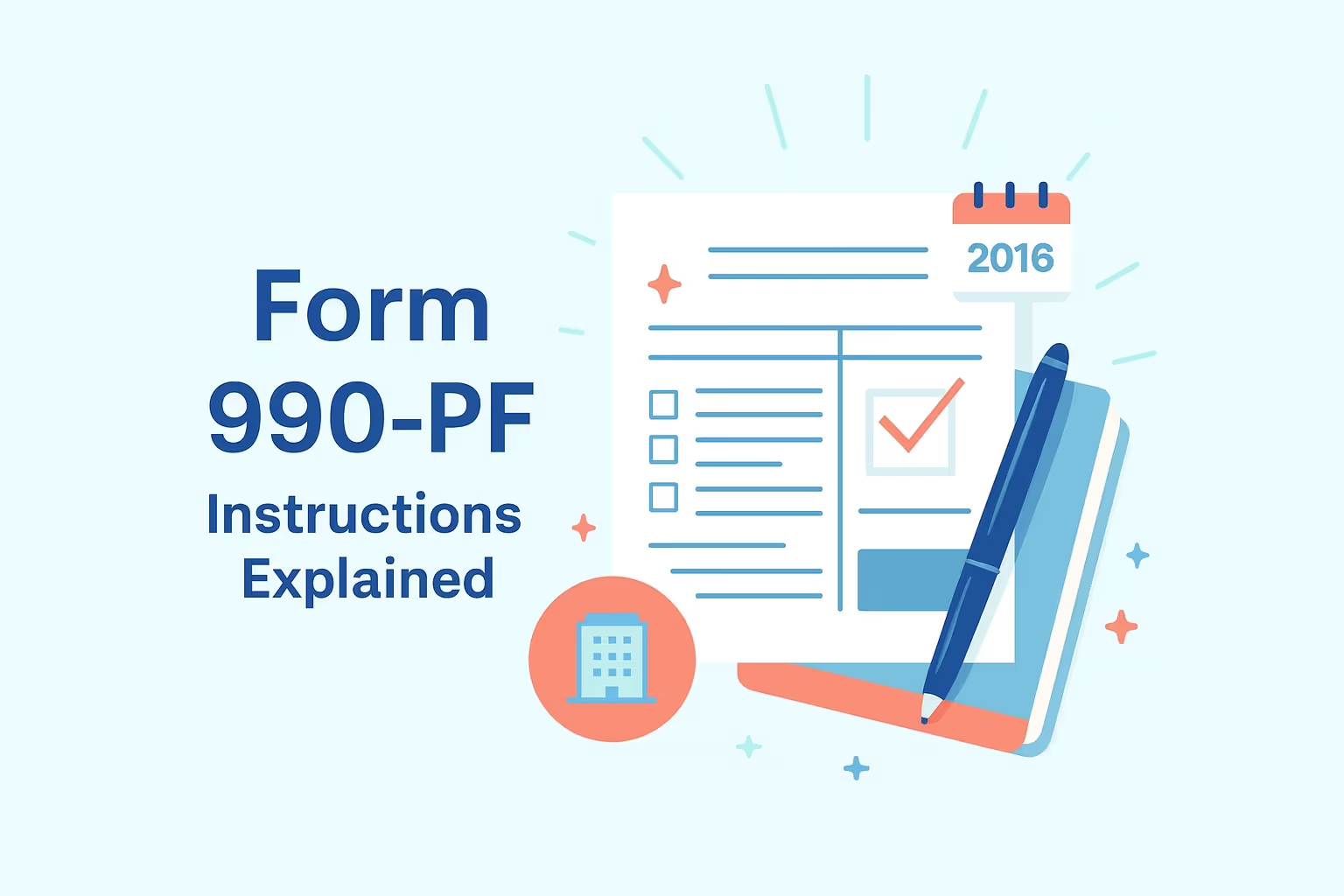Form 990-PF 2013 Instructions for Exempt Organizations
Filing Form 990-PF for the 2013 tax year is a key compliance requirement for tax-exempt organizations, private foundations, and certain charitable trusts. This return reports the foundation’s tax year activities, including investment income, charitable purposes, qualifying distributions, and other financial data that affect tax liability. Accurate reporting confirms private foundation status, maintains tax-exempt recognition, and demonstrates accountability to the Internal Revenue Service (IRS) and the public.
Many organizations find the filing process complex, especially when preparing an initial return or a final return. Each submission must clearly indicate the correct accounting period, accurately reconcile functional expenses, and document the minimum required investment return. Foundations must also include a current business mailing address, the name of the responsible party, and the physical location of the business. These elements ensure that the return accurately reflects the organization’s operations and meets IRS record-keeping expectations. Preparing early and reviewing all entries lowers the risk of errors and delays.
The IRS outlines specific reporting standards for private foundations and trusts filing under section 4947(a)(1) in the 2013 Instructions for Form 990-PF. These official directions clarify how to determine filing requirements, complete each part, and calculate excise tax on investment income. Reviewing them before completing the return helps ensure full compliance and accurate disclosure.
Understanding Form 990-PF and Its Purpose
Form 990-PF serves as the primary annual return for private foundations and specific tax-exempt organizations operating under section 4947(a)(1). This comprehensive document reports financial activities, compliance details, and governance information for each foundation’s tax year. It ensures the accurate disclosure of investment income, charitable purposes, qualifying distributions, and excise tax obligations, supporting accountability and transparency in the nonprofit sector.
The form allows organizations to demonstrate proper stewardship of charitable assets. Each filed return provides a public record that verifies the foundation’s tax-exempt status and demonstrates adherence to regulatory requirements. Accurate reporting supports evaluations by donors, grantees, and oversight agencies, which review financial performance and charitable outcomes to ensure accountability and transparency.
What Form 990-PF Reports
- Investment income is reported to show earnings from interest, dividends, rents, and securities, which determine the excise tax on net investment income.
- Charitable purposes are outlined to describe grants, scholarships, or direct charitable programs fulfilling the organization’s exempt mission.
- Functional expenses are detailed to separate costs for program services, management, or administrative support.
- Minimum investment return is calculated to determine the distributable amount required for compliance with annual payout rules.
- Qualifying distribution is reported to identify expenditures that reduce undistributed income for excise tax purposes.
- Supplemental information is provided to clarify complex transactions, exceptions, or additional disclosures required by the IRS.
Who Must File Form 990-PF
- Private foundations must submit the form annually, regardless of their income level or level of activity during the foundation’s tax year.
- Supporting organizations that have transitioned from public charity status to private foundation classification are required to file Form 990-PF.
- Disregarded entity structures must ensure the responsible party includes consolidated information reflecting all operations under the primary entity.
- New filers submitting an initial return must include the proper accounting period and confirm the organization’s foundation status.
- Entities terminating during dissolution must reconcile all undistributed income, remaining assets, and qualifying distributions.
Why the Form Matters
- Regulatory compliance is achieved through accurate reporting that fulfills federal requirements for tax-exempt organizations.
- Public disclosure is maintained through mandatory public inspection, promoting transparency and trust in the nonprofit community.
- Foundation evaluation is supported by consistent data reflecting financial health, operational activity, and charitable impact.
- Audit readiness is strengthened through documentation verifying program-related investments and excess business holdings.
Understanding the purpose and scope of Form 990-PF equips organizations to meet IRS expectations while preserving public confidence and demonstrating sound financial management.
Eligibility and Filing Requirements
Private foundations, supporting organizations, and certain tax-exempt trusts must confirm their filing obligations before preparing Form 990-PF for the 2013 tax year. Determining eligibility ensures compliance with federal disclosure standards for each entity’s foundation status and financial activity. Each organization must also verify whether it qualifies for electronic submission or if paper filing remains acceptable based on its reporting volume.
Who Must File for the 2013 Tax Year
Private foundations recognized as tax-exempt are required to file Form 990-PF, regardless of their income or activities. Section 4947(a)(1) trusts treated as private foundations are also required to report investment income, qualifying distributions, and functional expenses. Supporting organizations that no longer meet the requirements for public charity status must transition to a private foundation classification and complete this form.
Entities that use a disregarded structure ensure the responsible party consolidates all operations under the primary Employer Identification Number (EIN). New filers preparing an initial return must disclose the accounting period, business location, and business mailing address. Organizations closing operations must submit a final return reporting undistributed income, program-related investments, and qualifying distributions.
Filing Deadlines and Accounting Periods
Most foundations operate on a calendar year ending December 31, with returns due May 15 of the following year. Fiscal-year filers must submit their return on or before the fifteenth day of the fifth month after the close of the foundation’s tax year. Filers may request an automatic three-month extension using Form 8868.
Short-period returns apply when an accounting period changes or operations begin or end during the year. Filers must ensure all reported amounts align with the correct accounting period. Reporting revenue, expenses, and distributions in the correct accounting period ensures compliance with minimum investment return and excise tax requirements.
Electronic and Paper Filing Methods
Organizations filing 250 or more returns during a calendar year must file electronically. Smaller entities may file on paper if electronic submission is unavailable or impractical. The IRS provides instructions and submission options through its How to File page, which explains the required steps for both methods.
Each return must include all required schedules, supporting documentation, and the signature of the responsible party. Foundations should review each entry carefully to verify consistency across all parts. A complete and timely filing demonstrates accountability and supports ongoing recognition of tax-exempt status.
Meeting eligibility and filing requirements ensures private foundations maintain compliance with federal reporting laws. Adhering to correct filing procedures also strengthens transparency and supports long-term operational credibility.
Structure and Key Parts of Form 990-PF
Form 990-PF contains multiple sections that work together to present a complete picture of a private foundation’s financial activity, operations, and compliance status. Each part serves a specific function that ensures transparency, accurate accounting, and adherence to Internal Revenue Service (IRS) regulations. Understanding the role of each section in the foundation’s reporting obligations helps filers prepare a complete and consistent return.
The form comprises sixteen parts, each focusing on distinct areas of governance and finance. Foundational sections record gross receipts, functional expenses, and charitable purposes. Later sections cover capital transactions, tax calculations, and specialized disclosures that affect qualifying distribution requirements and minimum investment return. Each part must reflect consistent totals and align with the accounting method used throughout the return.
Revenue and Expense Reporting
Part I, titled “Analysis of Revenue and Expenses,” outlines the foundation’s revenue sources and related costs. Filers must disclose contributions, investment income, and other revenue streams while identifying direct and indirect expenses. The section requires figures for each column, including totals for book values, adjusted net income, and disbursements for charitable purposes.
- Report gross receipts from all sources, including grants, gifts, and contributions.
- Record investment income, such as dividends, interest, and rent.
- List functional expenses allocated to program, management, and administrative categories.
- Reconcile totals to reflect actual disbursements supporting charitable purposes.
Completing Part I accurately ensures transparency into how funds support exempt activities. Each line item connects to other sections that address qualifying distribution calculations and undistributed income. Consistency across these entries supports audit readiness and compliance with excise tax rules.
Balance Sheets and Asset Valuation
Part II focuses on beginning and end-of-year balance sheet reporting. Filers must include cash, investments, land, buildings, and equipment at their book values. If total assets exceeded $5,000 during the foundation’s tax year, fair market values must also be disclosed.
Reporting accurate valuations ensures compliance with IRS standards for determining minimum investment return. Each entry should reflect the foundation’s records and reconcile with amounts in supporting schedules. Errors in valuation can impact excise tax liability and the requirements for qualifying distributions.
Capital Transactions and Investment Calculations
Part IV addresses capital gains and losses, which are used to determine excise tax assessments. Filers must identify sales, exchanges, or disposals of assets, showing cost, sale price, and resulting gain or loss. Accurate data in Part IV supports proper reporting in Part VI, where excise tax liability is finalized.
Part V covers eligibility for reduced excise tax rates based on distribution performance. To qualify, foundations must meet specific payout thresholds tied to investment income and prior-year activity. Each calculation must use verified figures from other parts to avoid misstatements.
Compliance, Activities, and Governance
Parts VII and VIII request detailed responses about foundation operations and leadership. Part VII contains yes-or-no questions addressing self-dealing, excess business holdings, and other regulated transactions. Part VIII lists officers, directors, and key employees, including names, titles, and compensation.
- Report business relationships between key individuals and the foundation.
- Provide details on changes to or reclassifications of public charity status.
- Include supplemental information describing exceptions or program-related investments.
Completing each section of Form 990-PF with precision strengthens accountability and promotes continued recognition of tax-exempt status. When each part is prepared with consistent documentation and review, the return reflects the foundation’s mission, financial stewardship, and commitment to regulatory transparency.
Financial Reporting and Accounting Methods
Accurate financial reporting on Form 990-PF ensures private foundations and tax-exempt organizations demonstrate transparency and compliance with federal standards. Each figure aligns with the organization’s accounting records, supports audit readiness, and reflects proper categorization of all financial activities. Selecting the correct accounting method and consistently applying it across all schedules helps prevent discrepancies and filing delays.
Organizations must identify the accounting period that defines their foundation’s tax year. Reporting should match the period indicated in the heading of the return and cover all transactions that occurred within that timeframe. Consistent application of accounting methods establishes credibility with regulators and simplifies future filings for ongoing compliance.
Each filer must choose between cash and accrual accounting when preparing the return. Cash accounting recognizes income and expenses when money is exchanged, while accrual accounting records transactions when they are earned or incurred. The selected method must remain uniform across all parts of the form, including those addressing investment income, qualifying distributions, and functional expenses.
To ensure accurate and complete reporting, organizations should verify all entries across revenue and expense categories. Each section must capture detailed amounts that reflect actual operations and support required calculations for excise tax and minimum investment return. Filers confirm that total expenses and income match all related parts of the return and provide explanations within supplemental information.
- Record all investment income, including dividends, interest, and rents, in the designated revenue sections.
- Categorize functional expenses into program services, management, and administrative costs for clarity and compliance.
- Reconcile totals across all schedules to reflect consistent figures for revenue, distributions, and fund balances.
- Report deposits for employment taxes and confirm timely payments in accordance with federal guidelines and regulations.
- Calculate excise tax liability using verified data from Parts IV and VI of the form.
- Ensure qualifying distributions meet minimum investment return requirements established for private foundations.
- Disclose any exceptions or adjustments with clear explanations in supplemental attachments to ensure transparency and accountability.
Meticulous documentation and review help foundations maintain compliance and avoid reporting errors that could affect their tax-exempt status. Each number on the return should be supported by reliable records that substantiate the foundation’s financial position and activities. Effective financial reporting reinforces the organization’s accountability and commitment to lawful administration of charitable assets.
Compliance, Governance, and Management
Strong governance and effective compliance practices ensure private foundations maintain their tax-exempt status and uphold public trust. Each organization must demonstrate that its operations align with federal regulations and support its charitable mission. Transparent oversight, accurate reporting, and consistent documentation create a clear record of accountability throughout the foundation’s tax year.
- Self-Dealing Rules: Private foundations must identify and disclose any transactions involving disqualified persons, including substantial contributors, officers, directors, and their family members. Self-dealing can include loans, sales, or services exchanged between the foundation and related individuals or entities. Proper reporting prevents additional excise tax assessments and preserves organizational integrity.
- Responsible Party: The responsible party, typically a foundation officer or trustee, must review, sign, and certify the accuracy of each return. This individual ensures that all sections reflect the organization’s operations and financial activity. A verified signature affirms accountability for compliance and completeness of the filing.
- Public Charity Status: Foundations transitioning from public charity to private foundation classification must reflect this change within their return. Updated foundation status ensures accurate reporting under the applicable sections of the Internal Revenue Code. Transparency during reclassification helps maintain recognition of tax-exempt status.
- Business Location: Filers must report a valid business location and business mailing address that accurately represents their operational base. The address should match IRS records to prevent correspondence delays or processing issues. Each location entry must remain consistent across all filings and schedules.
- Public Support Tracking: Organizations must document contributions received from the public, including grants, donations, and investment income. Accurate public support tracking distinguishes between exempt function revenue and unrelated business income. Consistent records ensure reliable financial representation and support eligibility for reduced excise tax rates.
- Governance Oversight: Boards and officers must maintain written policies covering conflicts of interest, expenditure approvals, and grant-making procedures. Documented oversight safeguards against misuse of assets and promotes sound management practices. Meeting minutes and resolutions should accurately reflect decisions that influence tax liability or program-related investments.
- Documentation and Review: Comprehensive recordkeeping ensures each transaction aligns with the organization’s charitable purposes. Periodic internal reviews help identify discrepancies and confirm ongoing compliance with reporting requirements. Regular evaluations strengthen operational effectiveness and support long-term sustainability.
Effective compliance and governance management reinforce the foundation’s credibility within the nonprofit sector. Each action, policy, and disclosure contributes to sustaining public confidence and ensuring that charitable resources serve their intended purposes under federal law.
Public Disclosure and Record Retention
Private foundations and tax-exempt organizations are required to provide public access to certain filings and maintain accurate records that support their financial activities. These obligations promote transparency, build donor confidence, and demonstrate compliance with federal disclosure requirements. Clear recordkeeping practices also help organizations prepare future returns and support responses to Internal Revenue Service (IRS) inquiries.
Public inspection rules apply to all organizations filing Form 990-PF. Each filer must make specific documents available upon request, either electronically or at a designated business location. Providing timely access to these records affirms the foundation’s commitment to transparency and accountability within the charitable sector.
- Provide public inspection of the three most recent Form 990-PF filings, including all attachments and schedules.
- Make available the organization’s original tax exemption application and IRS determination letter confirming its tax-exempt status.
- Charge reasonable copying costs that reflect actual expenses, with no additional administrative charges.
- Restrict disclosure of donor names or addresses that appear on Schedule B or similar attachments.
Foundations must also develop consistent record retention policies to preserve evidence of their operations and compliance efforts. Proper documentation ensures that financial data, board decisions, and grant activity are verifiable for auditors and regulators. Each organization should evaluate internal storage and retrieval systems to confirm accessibility and data security.
- Maintain financial statements, receipts, and bank records for at least seven years.
- Retain grant agreements, board minutes, and investment reports that reflect qualifying distributions and program-related investments.
- Store employment tax filings and related payroll documentation for no fewer than four years.
- Secure digital records with restricted access to prevent unauthorized alterations or deletions.
Public disclosure and thorough record retention strengthen the foundation’s reputation for integrity and accountability. Adhering to these practices ensures that information remains accessible, complete, and aligned with federal requirements throughout the foundation’s tax year.
Penalties, Amendments, and Common Filing Mistakes
Filing Form 990-PF requires precision and attention to detail to ensure compliance with federal reporting obligations. Mistakes or omissions may result in additional processing time or correspondence from the Internal Revenue Service (IRS). Awareness of common filing errors enables organizations to strengthen their reporting practices and maintain their tax-exempt status.
Common Issues
- Late submissions occur when organizations miss the due date or fail to request an extension using Form 8868.
- Include indicators for an initial or final return to avoid confusion regarding an organization’s filing history and operational status.
- Inconsistent figures across sections undermine financial accuracy and raise questions during IRS review.
- Unreconciled amounts between the revenue and expense sections lead to errors in determining the qualifying distribution and excise tax liability.
- Omitted attachments or incomplete schedules reduce transparency and increase the likelihood of compliance inquiries.
- Inaccurate entries for gross receipts, investment income, or functional expenses affect reporting integrity.
- Missing supplemental explanations for exceptions or unique transactions weakens the organization’s supporting documentation.
Correction Steps
- File an amended return using the same Form 990-PF and check the box labeled “Amended Return” in the heading section.
- Include all parts and schedules, even if unchanged, to ensure the revised filing remains complete.
- Provide written explanations within supplemental attachments describing each modification.
- Confirm that the updated amounts are reflected throughout all relevant parts, including balance sheets and distribution sections.
- Recalculate excise tax obligations and other affected totals before submitting the revised form.
- Retain both the original and amended copies with supporting documentation for recordkeeping.
Preventing Future Mistakes
- Conduct a pre-filing review that compares totals across parts and schedules for consistency.
- Assign oversight to a responsible party familiar with IRS reporting requirements for private foundations.
- Use reliable accounting software or a professional review to ensure calculations and classifications meet federal standards.
- Maintain a detailed filing checklist addressing all required schedules, signatures, and attachments.
- Consult a qualified tax professional with experience in exempt organization reporting for complex issues.
Proactive error prevention and timely corrections ensure that each filing meets IRS expectations. Accurate reporting reinforces compliance, supports organizational credibility, and protects the foundation’s long-term tax-exempt recognition.
Frequently Asked Questions
What is the due date for filing Form 990-PF for tax year 2013?
The due date for filing Form 990-PF is the fifteenth day of the fifth month after the end of the foundation’s tax year. For organizations following a calendar year, the filing deadline is May 15, 2014. Filers requiring additional time may request a three-month automatic extension using Form 8868. Each submission should include accurate financial data, schedules, and any additional required information to ensure compliance with reporting requirements.
How should a foundation report its investment income and related excise tax?
Foundations must report investment income in Part I of Form 990-PF, including dividends, interest, and capital gains. These figures are used in Part III to determine excise tax liability on net investment income. The rate generally equals two percent but may be reduced if specific qualifying distribution requirements are met. Each entry must match the supporting documentation and align with other sections that reflect total revenue, expenses, and qualifying charitable activities.
When should a foundation file an initial or final return?
An initial return must be filed during the organization’s first operational year, reflecting all gross receipts and expenditures for the period. A final return is required when the foundation terminates, merges, or changes its classification. Each return should accurately list both the beginning and ending net assets, as well as details on distributions and grantmaking activities. A clear record of closure activities ensures compliance with Internal Revenue Service requirements for exempt organizations.
How should a filer handle reporting additional information on Form 990-PF?
Organizations must provide additional information in designated sections or attach supplemental schedules explaining complex transactions. Each explanation should clarify unusual transactions, exceptions, or adjustments that affect financial reporting. Explanations may include notes about asset transfers, investment income reconciliations, or changes in accounting methods. Attachments follow the format in official IRS documents to maintain transparency and ensure all disclosures meet federal reporting standards.
What happens if an organization’s gross receipts fall below the filing threshold?
Organizations with annual gross receipts of $50,000 or less may not need to file the full Form 990-PF. Some other nonprofits may qualify to file an e-Postcard or Form 990-EZ, depending on their structure and foundation status. Each filer must verify eligibility based on income, asset levels, and operational type. Maintaining accurate records ensures that each organization selects the appropriate filing option in accordance with current IRS requirements.
How should foundations handle deposit employment taxes?
Private foundations with employees are required to deposit employment taxes in accordance with IRS regulations. Payments include federal income tax withheld, Social Security, and Medicare contributions. Timely deposits prevent interest charges and preserve compliance. Organizations must also reconcile payroll records with annual reporting forms. Clear documentation ensures that employment tax obligations remain aligned with the foundation’s financial activities and maintain accuracy across Form 990-PF and related schedules.
Where can filers find the official 2013 Form 990-PF and its schedules?
The official 2013 Form 990-PF includes all necessary parts, schedules, and instructions for completing each section accurately. Filers should review requirements for reporting investment income, qualifying distributions, and charitable purposes. Each part contains detailed line items that reflect the foundation’s financial activity, including balance sheets and grant disclosures. Reviewing the official form before preparation ensures submissions are complete and compliant for the organization’s designated tax year.




























